How to Rebalance the Land-Use Structure after Large Infrastructure Construction? From the Perspective of Government Attention Evolution
Abstract
:1. Introduction
2. Materials and Methods
2.1. Overview of the Study Area
2.2. Research Method
2.2.1. Spatial Analysis
2.2.2. Natural Language Processing
2.3. Data Source and Processing
2.3.1. Land-Use Data Sources and Processing
2.3.2. Natural Language Processing Data Source and Processing
3. Results
3.1. Comparison of Land-Use Status from 2009 to 2019
3.2. Results of Land-Use Adjustment from the Perspective of Government Attention
3.2.1. Create Attention: Reservoir Construction as the Center of Gravity
3.2.2. Reinforce Attention: Building Reservoirs at the Expense of Cultivated Land
3.2.3. Adjust Attention: Scale of Supplementary Cultivated Land
3.2.4. Divert Attention: Negative Impact of Newly Cultivated Land
3.3. RLCCP Evolution Mechanism from the Perspective of Local Government
3.3.1. Create Attention: Generation Period of RLCCP
3.3.2. Reinforce Attention: Challenge Period of RLCCP
3.3.3. Adjust Attention: Marked Effect Period of RLCCP
3.3.4. Divert Attention: Continuous Negative Impact Period of RLCCP
4. Discussion
5. Conclusions
6. Prospect
Author Contributions
Funding
Data Availability Statement
Conflicts of Interest
References
- FAO; IFAD; UNICEF; WFP; WHO. The State of Food Security and Nutrition in the World 2022. Repurposing Food and Agricultural Policies to Make Healthy Diets More Affordable; FAO: Rome, Italy, 2022. [Google Scholar] [CrossRef]
- Song, J.; Ye, J.; Zhu, E.; Deng, J.; Wang, K. Analyzing the impact of highways associated with cultivated-land loss under rapid urbanization. ISPRS Int. J. Geo Inf. 2016, 5, 94. [Google Scholar] [CrossRef]
- Liang, X.Y.; Jin, X.B.; Sun, R.; Han, B.; Ren, J.; Zhou, Y.K. China’s resilience-space for cultivated-land protection under the restraint of multi-scenario food security bottom line. Acta Geogr. Sin. 2022, 77, 697–713. (In Chinese) [Google Scholar] [CrossRef]
- Xiong, C.; Beckmann, V.; Tan, R. Effects of infrastructure on land use and land cover change (LUCC): The case of Hangzhou International Airport, China. Sustainability 2022, 10, 2013. [Google Scholar] [CrossRef]
- Cao, Y.; Zhou, W.; Wang, J.; Yuan, C. Spatial-temporal pattern and differences of land use changes in the Three Gorges Reservoir Area of China during 1975–2005. JMS 2011, 8, 551–563. [Google Scholar] [CrossRef]
- Yan, J.; Xiao, R.; Su, F.; Bai, J.; Jia, F. Impact of Port Construction on the Spatial Pattern of Land Use in Coastal Zones Based on CLDI and LUT Models: A Case Study of Qingdao and Yantai. Remote Sens. 2021, 13, 3110. [Google Scholar] [CrossRef]
- Yang, S.Q.; Zhu, G.R.; Liu, J.; Tu, H.L. The Research Progress of the Traffic Ecological Effects under the Perspective of “Pattern-Process-Function”. Ecol. Environ. Sci. 2022, 31, 634–642. (In Chinese) [Google Scholar] [CrossRef]
- Wang, Y.N.; Shi, P.J.; Liu, C.F.; Zhang, X.B.; Xu, Y.L. Potential Land Use Competition Risk ldentification in Rapid Agglomeration City-A Case Study of Lanzhou New District. Resour. Dev. Mark. 2016, 32, 1415–1419. [Google Scholar] [CrossRef]
- Bai, L.M.; Feng, X.H.; Sun, R.F.; Gao, H. Spatial and temporal responses of habitat quality to urbanization: A case study of Changchun City, Jilin Province, China. Chin. J. Appl. Ecol. 2020, 31, 1267–1277. [Google Scholar] [CrossRef]
- Zhao, J.; Gao, Z.L.; Cai, Y.R. Impacts of Expressway Construction on Land Use Types and Assessment on the Ecosystem Service Value—A Case Study of Five Typical Areas in Shaanxi Province. Res. Soil Water Conserv. 2011, 18, 226–231+237. [Google Scholar]
- Guo, H.L.; Zhou, Q.G. Effect of Land Use Change on Ecosystem Service Value Pre and Post the Water Storage in the Three Gorges Reservoir Area. Res. Soil Water Conserv. 2016, 23, 222–228. (In Chinese) [Google Scholar] [CrossRef]
- Siciliano, G.; Urban, F. Equity-based natural resource allocation for infrastructure development: Evidence from large hydropower dams in Africa and Asia. Ecol. Econ. 2017, 134, 130–139. [Google Scholar] [CrossRef]
- Xu, Z.M. Research on Land Use Conflict Management Based on Stakeholder Theory; Zhejiang University: Hangzhou, China, 2011. (In Chinese) [Google Scholar]
- Ruan, S.T.; Wu, K.N. Research of the Land Use Conflict and Mitigation Mechanism During the Urbanization in China. China Popul. Resour. Environ. 2013, 23 (Suppl. S2), 388–392. [Google Scholar]
- Yu, B.H.; Lv, C.H. The Progress and Prospect of Land Use Conflicts. Prog. Geogr. 2006, 25, 106–115. (In Chinese) [Google Scholar]
- Zhou, D.; Xu, J.C.; Wang, L. Process of Land Use Conflict Research in China During the Past Fifteen Years. China Land Sci. 2015, 29, 21–29. (In Chinese) [Google Scholar] [CrossRef]
- Bergius, M.; Benjaminsen, T.A.; Maganga, F.; Buhaug, H. Green economy, degradation narratives, and land-use conflicts in Tanzania. World Dev. 2020, 129, 104850. [Google Scholar] [CrossRef]
- Sabir, M.; Torre, A. Land-Use Conflicts and Social Capital: The question of infrastructure projects in rural development. Ann. Reg. Sci. 2020, 70, 757–777. [Google Scholar] [CrossRef]
- Wang, Y.; Li, P.Z.; Wang, H.Y.; Shao, X.D.; Li, Y. Evolution of land use conflicts and their stakeholders’ contradiction and combination relationship in Northeast China. J. Arid Land Resour. Environ. 2021, 35, 65–70. (In Chinese) [Google Scholar] [CrossRef]
- Magsi, H.; Sabir, M.; Torre, A.; Chandio, A.A. Management practices to minimize land use conflicts on large-infrastructure projects: Examples of dams construction in Pakistan. Geosci. J. 2021, 87, 4851–4861. [Google Scholar] [CrossRef]
- Sardaro, R.; Faccilongo, N.; Roselli, L. Wind farms, cultivated-land occupation and compensation: Evidences from landowners preferences through a stated choice survey in Italy. Energy Policy 2019, 133, 110885. [Google Scholar] [CrossRef]
- Padeiro, M. Conformance in land-use planning: The determinants of decision, conversion and transgression. Land Use Policy 2016, 55, 285–299. [Google Scholar] [CrossRef]
- Blizzard, A.F.; Mangun, W.R. Intergovernmental influences on the implementation of coastal zone management in the United States: Public shoreline access in the Southeast. Ocean. Coast Manag. 2008, 51, 443–449. [Google Scholar] [CrossRef]
- Kondolf, G.M.; Lopez-Llompart, P. National-local land-use conflicts in floodways of the Mississippi River system. AIMS Environ. Sci. 2018, 5, 47–63. [Google Scholar] [CrossRef]
- Klauer, B.; Küblböck, K.; Omann, I.; Karutz, R.; Klassert, C.; Zhu, Y.; Zozmann, H.; Smilovic, M.; Talozi, S.; Figueroa, A.J.; et al. Stakeholder Workshops Informing System Modeling—Analyzing the Urban Food–Water–Energy Nexus in Amman, Jordan. Sustainability 2022, 14, 11984. [Google Scholar] [CrossRef]
- Shi, X.J. Study on the Evaluation of the Implementation of General Land Use Planning; Jiangsu University of Science and Technology: Zhenjiang, China, 2020; pp. 27–30. (In Chinese) [Google Scholar] [CrossRef]
- Gui, H. Practical Balance in the Relationship between Central and Local Governments: An Analysis with Special Reference to Land Management Practice. Open Times 2022, 92–106. (In Chinese) [Google Scholar]
- Xia, Z.Z. Land system reform from the perspective of national governance. Seeker 2020, 143–150. (In Chinese) [Google Scholar] [CrossRef]
- Zhang, Y.M. Study on the Transformation and Countermeasures of cultivated-land Protection System-Construction of The Incentive System of Protection of cultivated-land. Chin. J. Agric. Resour. Reg. Plan. 2014, 35, 26–31. [Google Scholar]
- Xie, L.L.; Xu, J.L.; Zang, J.M.; Huang, T.N. Simulation and Prediction of Land Use Change in Guangxi Based on Markov—FLUS Model. Res. Soil Water Conserv. 2022, 29, 249–254 + 264. (In Chinese) [Google Scholar] [CrossRef]
- Simon, H.A. Administrative Behavior: A Study of Decision-Making Processes in Administrative Organi-Zation; Macmillan: New York, NY, USA, 1997. [Google Scholar]
- Bai, D. Research on Simon’s Limited Rational Decision-Making Thought; Dalian Maritime University: Dalian, China, 2017; pp. 21–22. (In Chinese) [Google Scholar]
- Xu, J.; Lu, L.D.; Wei, J.C. Hierarchical difference in attention allocation of local Governments: Explaining change and stability in safety management. Safety Sci. 2022, 152, 105789. [Google Scholar] [CrossRef]
- Gao, J.B.; Liu, Y.S.; Zhang, Y.X. Evolution of Temporal-spatial Pattern of Grain Production and Its Driving Mechanism in Huaihe River Basin During 1990–2012. Bull Soil Water Conserv. 2016, 36, 179–185+192. (In Chinese) [Google Scholar] [CrossRef]
- Huang, W.H. Legal interpretation of the State Council government work report and its constitutional connotation. Huxiang Forum. 2020, 33, 94–104. (In Chinese) [Google Scholar]
- Tuan, Y.F. Geography, phenomenology and the study of human nature. TCG 1971, 15, 181–192. [Google Scholar] [CrossRef]
- Innocenti, E.; Detotto, C.; Idda, C.; Parker, D.C.; Prunetti, D. An iterative process to construct an interdisciplinary ABM using MR POTATOHEAD: An application to Housing Market pattenls in touristic areas. Ecol. Complex 2020, 44, 100882. [Google Scholar] [CrossRef]
- Yang, Y.F.; Zhu, L.Q. The Theory and Diagnostic Methods of Land Use Conflicts. Res. Sci. 2012, 34, 1134–1141. [Google Scholar]
- Zou, L.L.; Liu, Y.S.; Wang, Y.S. Research Progress and Prospect of Land-use Conflicts in China. Prog. Geogr. 2020, 39, 298–309. (In Chinese) [Google Scholar] [CrossRef]
- Liu, Y.; Li, J.; Yang, Y. Strategic adjustment of land use policy under the economic transformation. Land Use Policy 2018, 74, 5–14. [Google Scholar] [CrossRef]
- Zeng, L.; Li, H.; Wang, X.; Yu, Z.; Hu, H.; Yuan, X.; Zhao, X.; Li, C.; Yuan, D.; Gao, Y.; et al. Chinas Transport Land: Spatiotemporal Expansion Characteristics and Driving Mechanism. Land 2022, 11, 1147. [Google Scholar] [CrossRef]
- Steinhäußer, R.; Siebert, R.; Steinführer, A.; Hellmich, M. National and regional land-use conflicts in Germany from the perspective of stakeholders. Land Use Policy 2015, 49, 183–194. [Google Scholar] [CrossRef]
- Wu, Y.S. Research on the Impact of Microblog Public Opinion on Government Attention Distribution; Huazhong University of Science and Technology: Hangzhou, China, 2019. (In Chinese) [Google Scholar] [CrossRef]
- Brasil, F.G.; Bichir, R. Policy Dynamics and Government Attention over Welfare Policies: An Analysis of the Brazilian Case. Braz. Political Sci. Rev. 2022, 16, e0007. [Google Scholar] [CrossRef]
- Wang, A.F.; Chen, S.H.; Wei, Y.Z.; Tang, X.L.; Dai, J.F. Land Use Conflict Based on F-H Method in theLijiang River Basin, China. J. Mount. Sci. 2021, 39, 506–514. (In Chinese) [Google Scholar] [CrossRef]
- Wang, J.J.; Wu, Z.P.; Wang, S.S.; Yin, H.H. An Analysis of The Pattern of Land-Use Conflicts in Valley Oases in Arid Areas. Remote Sens. Nat. Resour. 2021, 33, 243–251. [Google Scholar] [CrossRef]
- Shen, X.; Wang, L.; Wu, C.; Lv, T.; Lu, Z.; Luo, W.; Li, G. Local interests or centralized targets? How Chinas local government implements the cultivated-land policy of Requisition–Compensation Balance. Land Use Policy 2017, 67, 716–724. [Google Scholar] [CrossRef]
- Ren, D.P.; Peng, B. Research on the Rule of Legal Regulation to Prevent “Non-grain” of cultivated-land. China Land Sci. 2022, 36, 1–9. (In Chinese) [Google Scholar] [CrossRef]
- Qiu, Y.; Cao, G. The Heterogeneous Effects of Multilevel Location on cultivated-land Abandonment: A Village-Level Case Study in Taian City, China. Land 2022, 11, 1233. [Google Scholar] [CrossRef]
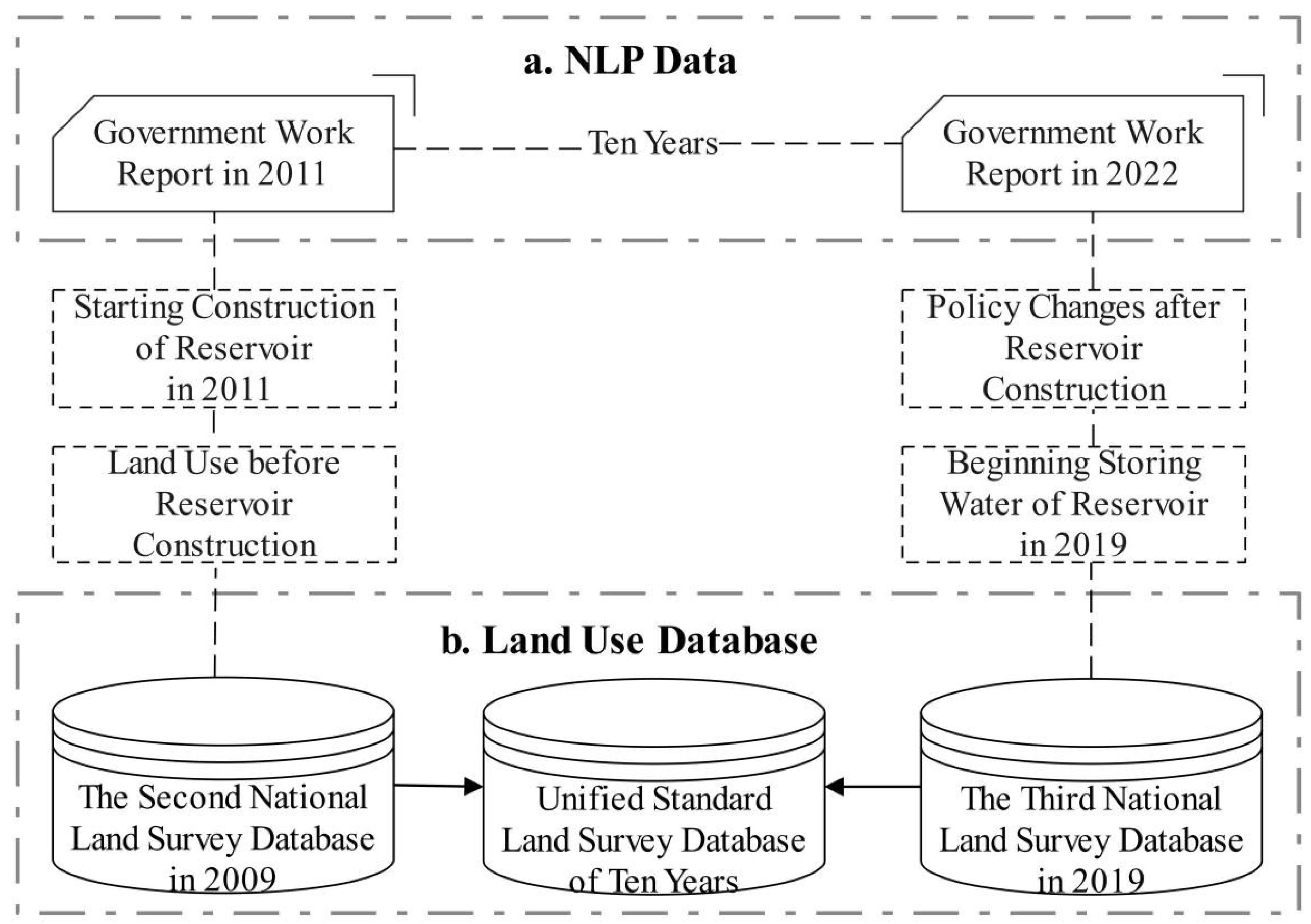
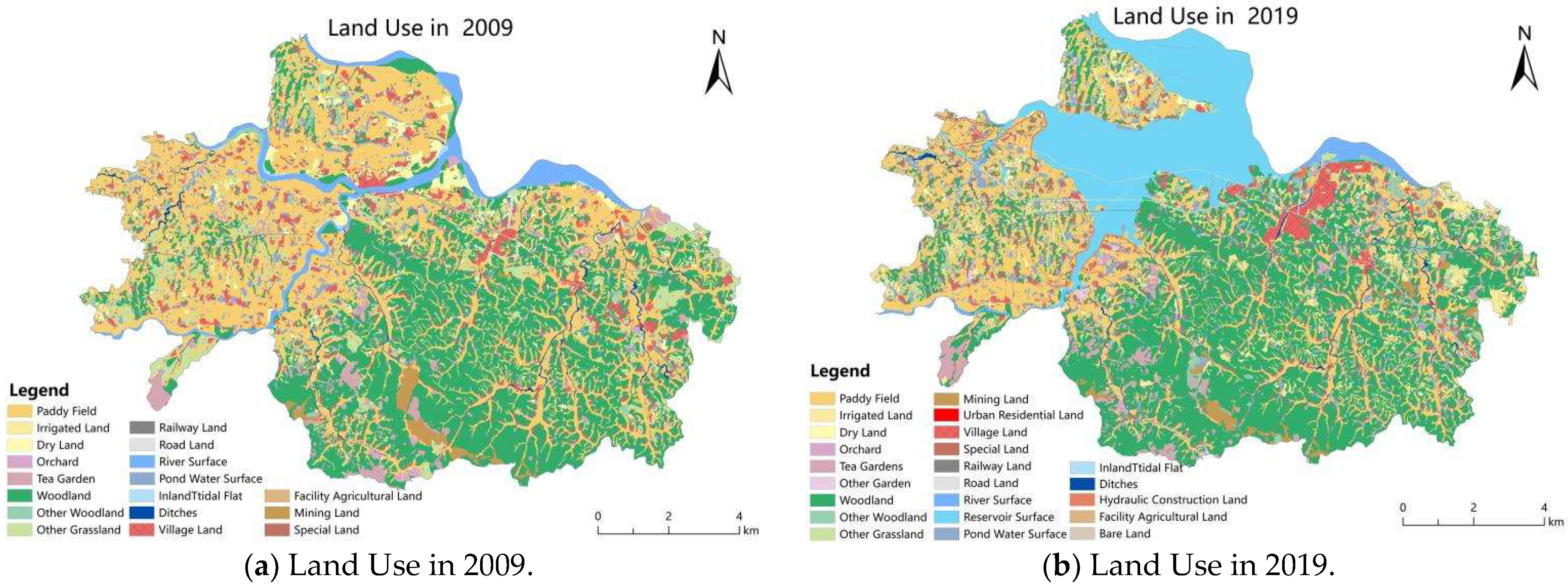
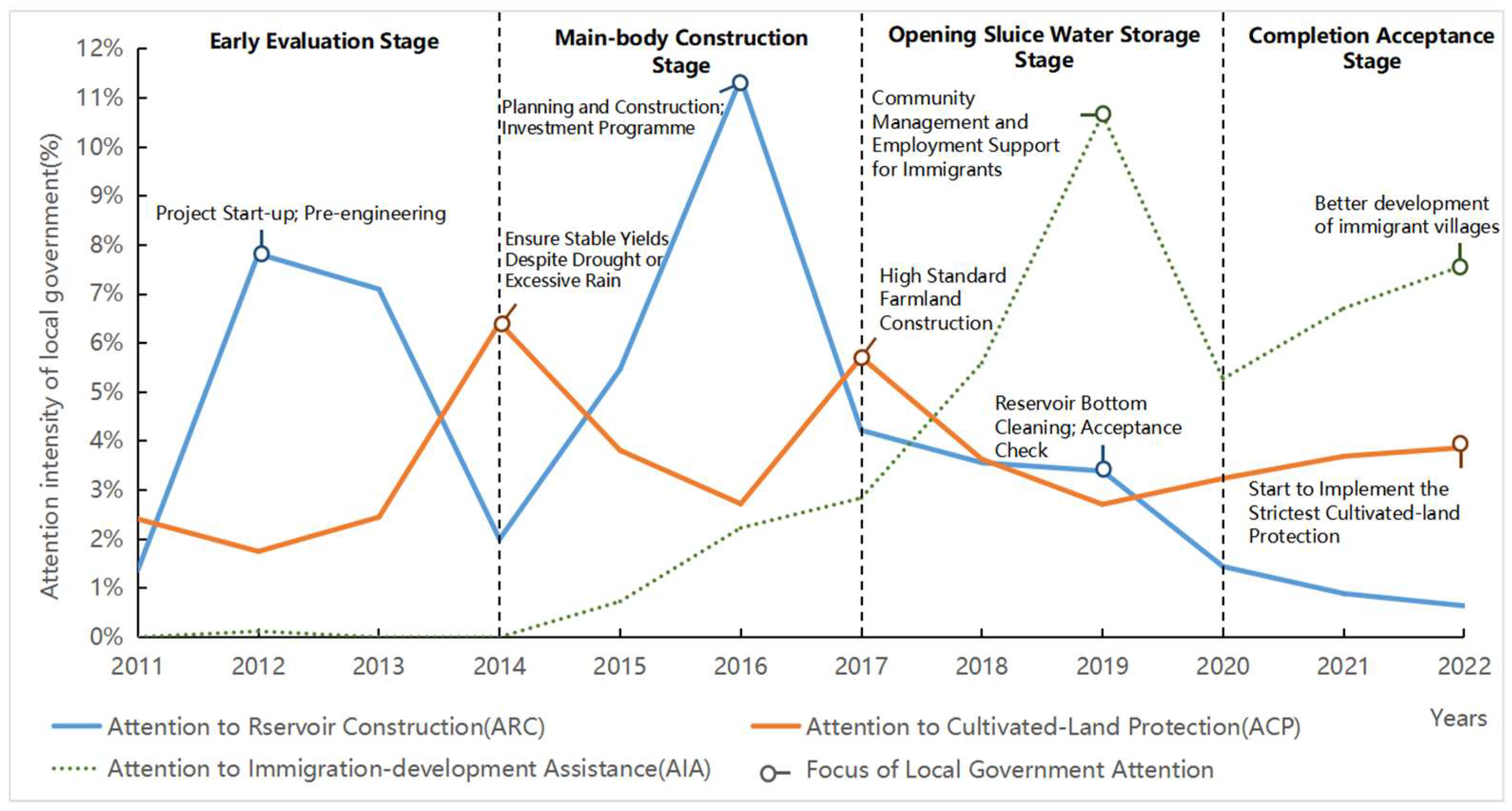
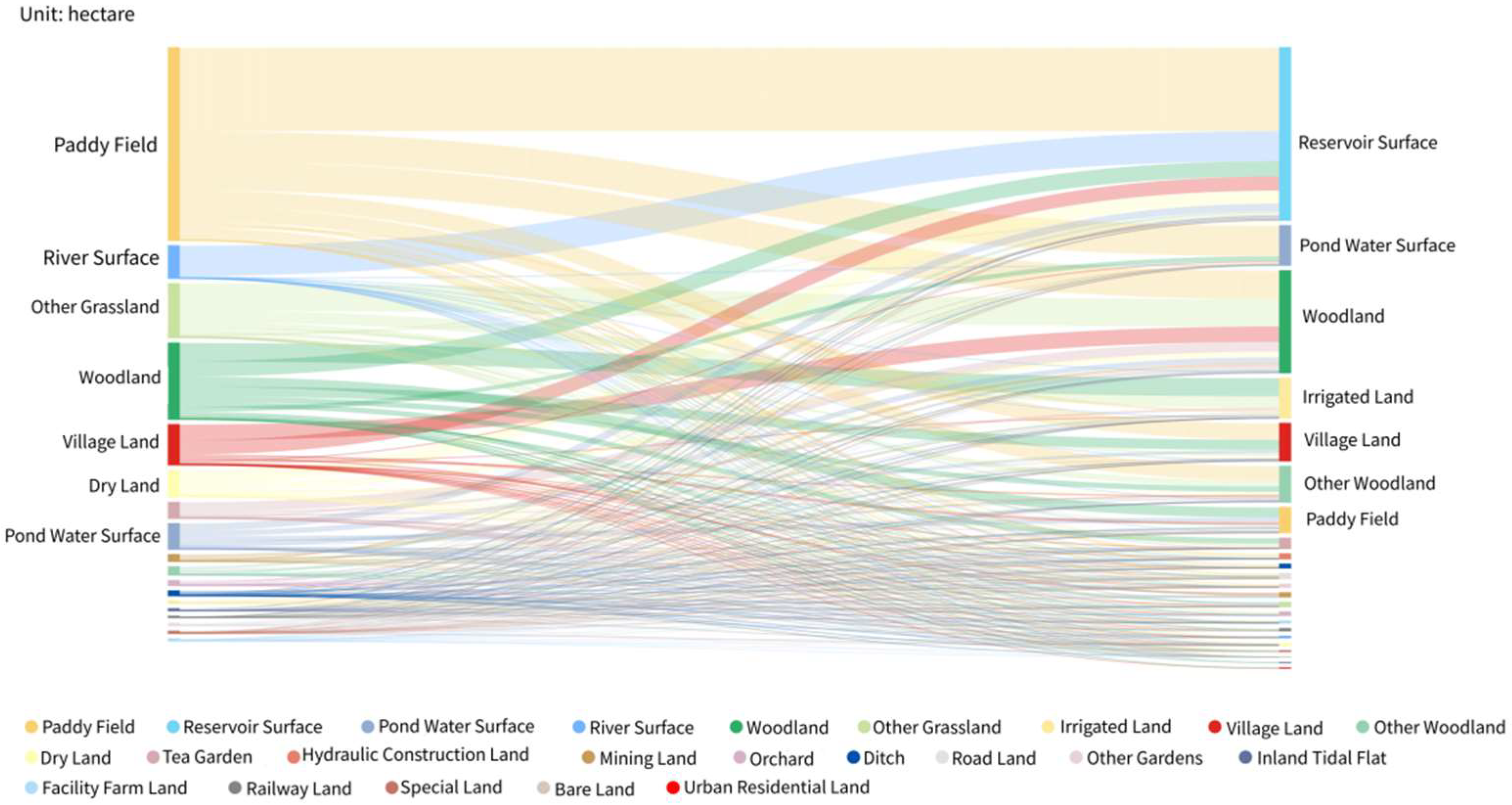

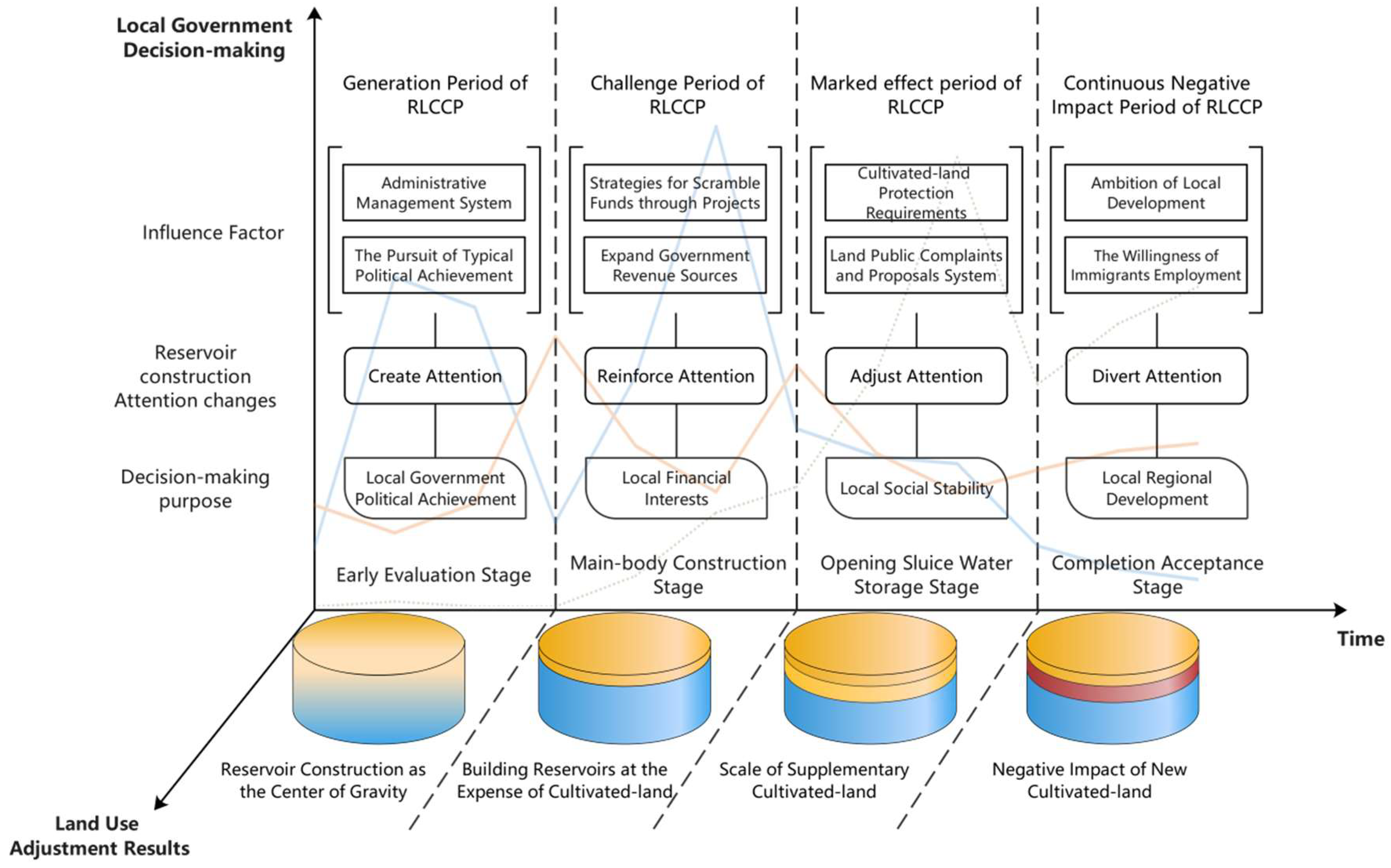
| Land Category Name | Land Category Name | ||
|---|---|---|---|
| Agricultural Land | Paddy Field | Construction Land | Mining Land |
| Irrigated Land | Urban Residential Land | ||
| Dry Land | Village Land | ||
| Orchard | Special Land | ||
| Tea Garden | Railway Land | ||
| Other Gardens | Road Land | ||
| Woodland | Reservoir Surface | ||
| Other Woodland | Hydraulic Construction Land | ||
| Pond Water Surface | Unused Land | Other Grassland | |
| Ditch | River Surface | ||
| Facility Agricultural land | Inland Tidal Flat | ||
| Bare Land |
Disclaimer/Publisher’s Note: The statements, opinions and data contained in all publications are solely those of the individual author(s) and contributor(s) and not of MDPI and/or the editor(s). MDPI and/or the editor(s) disclaim responsibility for any injury to people or property resulting from any ideas, methods, instructions or products referred to in the content. |
© 2023 by the authors. Licensee MDPI, Basel, Switzerland. This article is an open access article distributed under the terms and conditions of the Creative Commons Attribution (CC BY) license (https://creativecommons.org/licenses/by/4.0/).
Share and Cite
Gao, J.; Zhang, X.; Yu, C.; Ma, Z.; Sun, J.; Guan, Y. How to Rebalance the Land-Use Structure after Large Infrastructure Construction? From the Perspective of Government Attention Evolution. Land 2023, 12, 1632. https://doi.org/10.3390/land12081632
Gao J, Zhang X, Yu C, Ma Z, Sun J, Guan Y. How to Rebalance the Land-Use Structure after Large Infrastructure Construction? From the Perspective of Government Attention Evolution. Land. 2023; 12(8):1632. https://doi.org/10.3390/land12081632
Chicago/Turabian StyleGao, Junbo, Xinyi Zhang, Chao Yu, Zhifei Ma, Jianwu Sun, and Yujie Guan. 2023. "How to Rebalance the Land-Use Structure after Large Infrastructure Construction? From the Perspective of Government Attention Evolution" Land 12, no. 8: 1632. https://doi.org/10.3390/land12081632
APA StyleGao, J., Zhang, X., Yu, C., Ma, Z., Sun, J., & Guan, Y. (2023). How to Rebalance the Land-Use Structure after Large Infrastructure Construction? From the Perspective of Government Attention Evolution. Land, 12(8), 1632. https://doi.org/10.3390/land12081632









